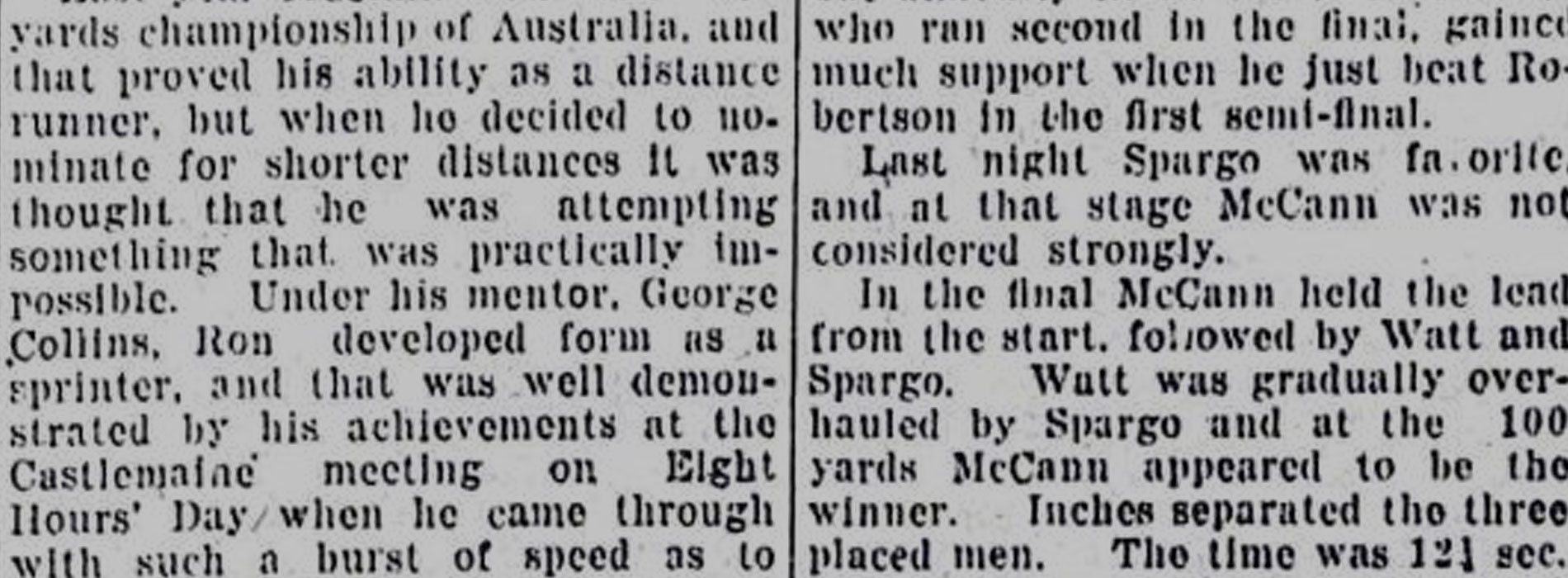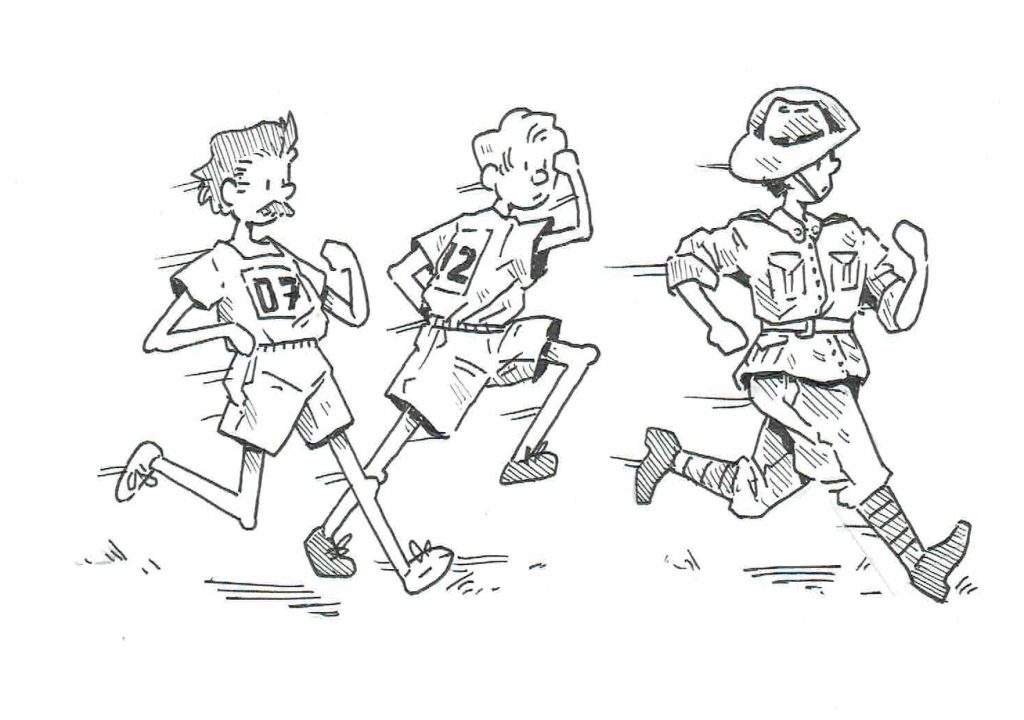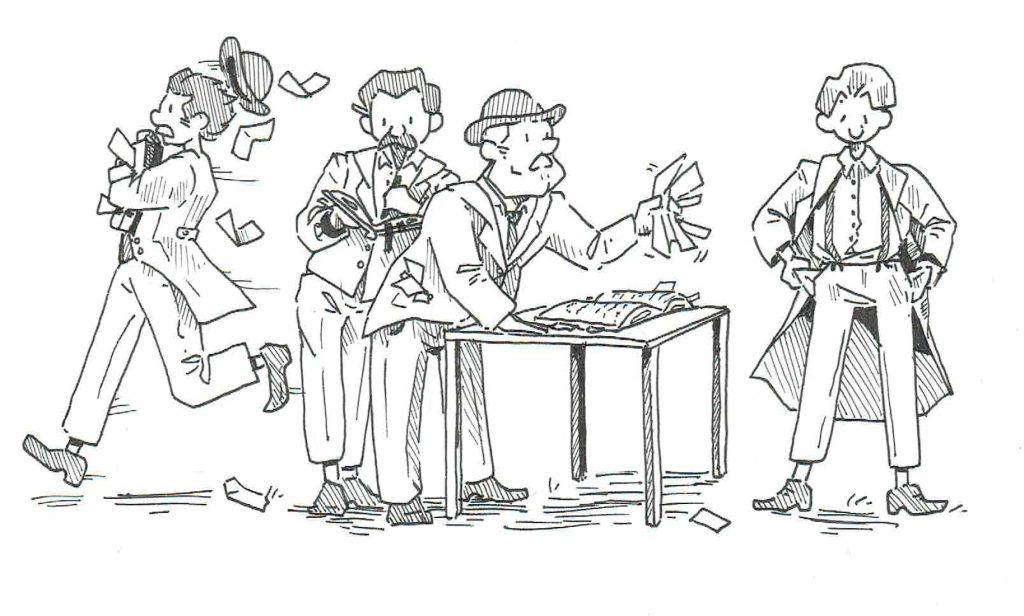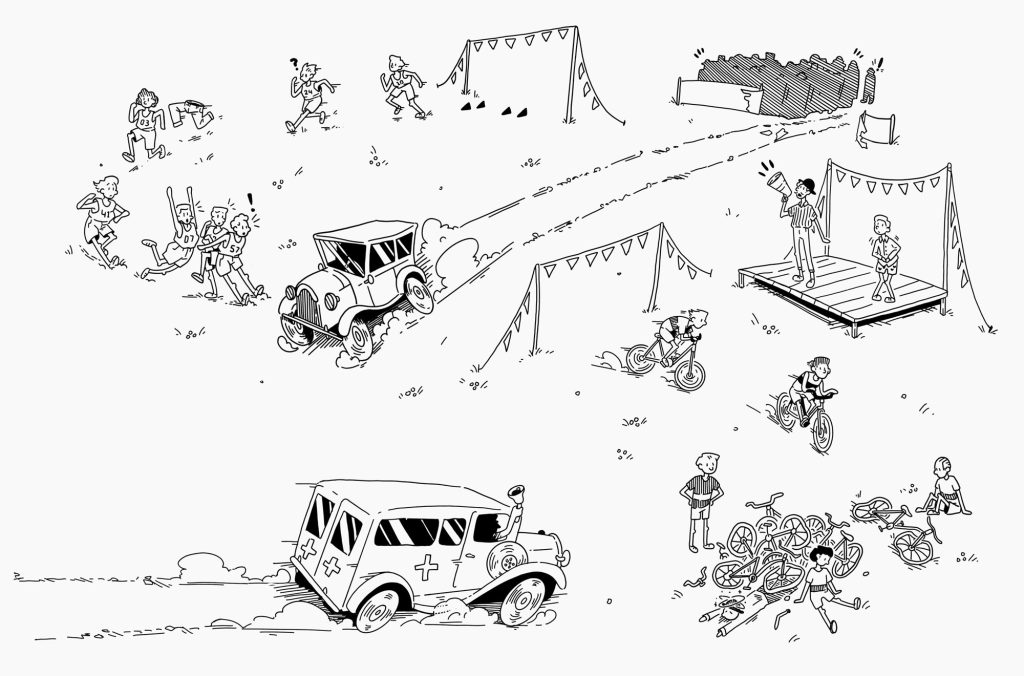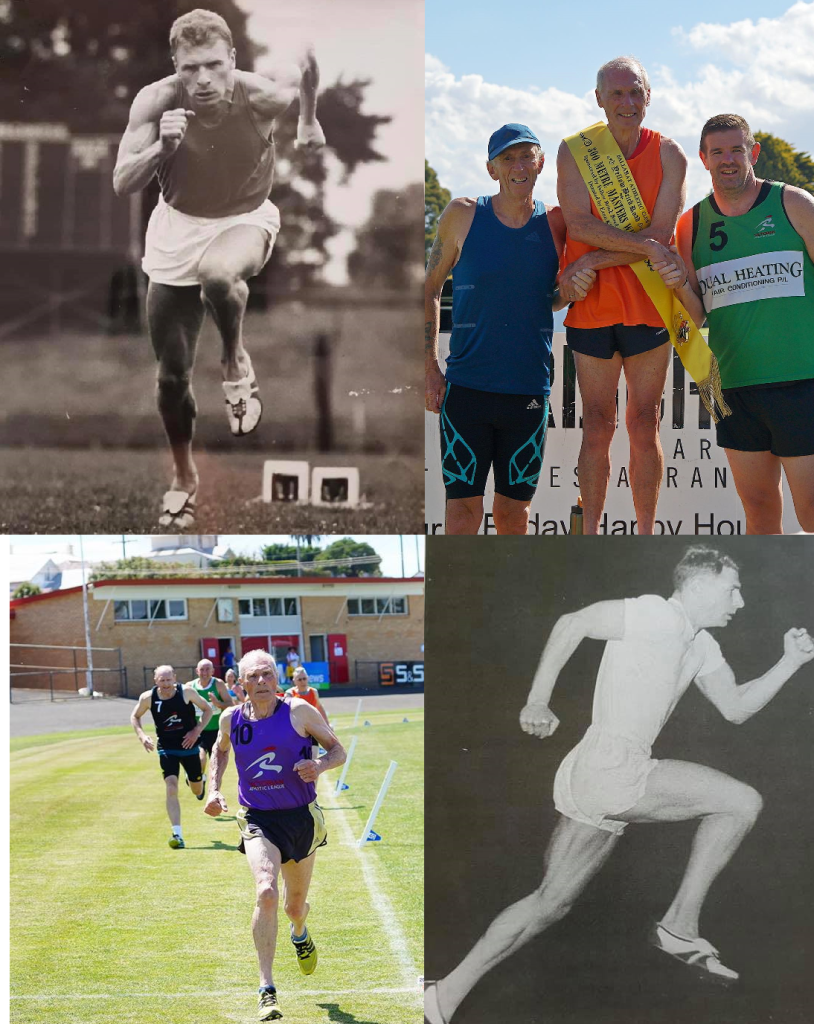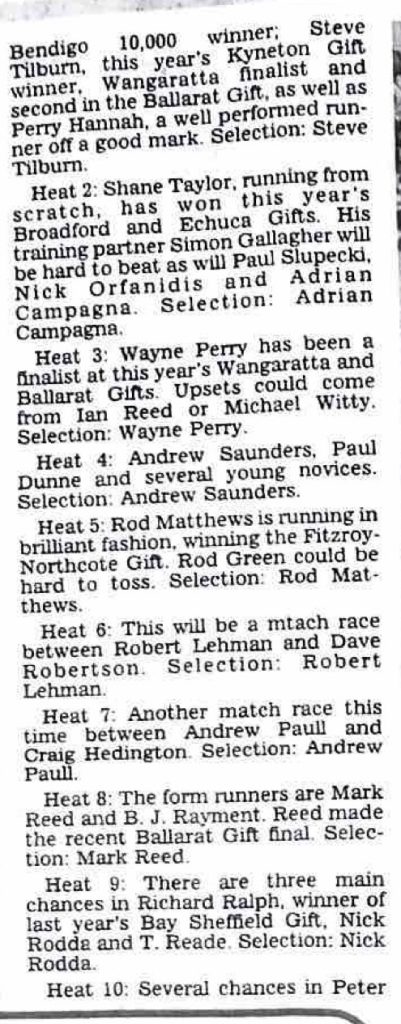The 1800s – Early Beginnings
Foot Races have been around locally since the 1860s. The North Western Gathering was an event that brought 40,000 – 50,000 miners to the local sporting event for entertainment. The Gathering would have offered more than just footraces, perhaps including boxing and pony races. Prize money was offered to the winners. With such a large draw of attendees the North Western Gathering didn’t always run smoothly, and was no stranger to the occasional controversy as a result.
On January 3rd 1861, an instance of this controversy was reported by the Mount Alexander Times:
A Castlemaine man, Mr. Bythell ran in the 600 yards race (approx. 550 metres*) with 3 other runners, all of whom were professional athletes: Mr. Mills, Mr. Emery and Mr. Joshua. As the race began, Joshua took the lead; followed by Bythell. But, as they ran – Bythell found himself seemingly blockaded by Mills and Emery. The athletes ‘shepherded’ Bythell so that he could neither overtake them, nor Joshua – who continued to race ahead. (1)
Supposedly, these runners were involved in similar instances of shepherding in the 600 yard race. The crowd also seemed to notice the apparent tampering and began creating a scene. The Mount Alexander Times continued:
Likely it was that a friend of Bythell was first to speak up while watching with the other spectators. In anger or frustration they jumped out of the crowd running over to Mills – yelling at, and attacking him. The police stepped in, singling out William Edwards, a noteable runner from the district.
Edwards denied any involvement; and with no confession or reasonable evidence to hold him- the police had to let him go. (2)
It remains likely that the real assailant vanished into the noisy commotion of the crowd leaving Edwards to be accused. And Bythell was still credited with second place for the race.
The shifty practices seem to have continued throughout the day with the 150 yard race (approx. 140 metres*).
A Castlemaine runner, Mr. McCrae, was nearly forced out of second place as well. But, after protests from McCrae, the Committee who were overseeing the races acknowledged the tampering, and honoured his position in second. Joshua also won this race.
The third race, a half-mile (approx. 800 metres distance*) hurdle event was also won by Joshua. The race was over 8 hurdles, at 3 ½ feet high (approx. 107 cm height*). (3)
Joshua demonstrated huge prowess at the North Western Gathering as a successful professional pedestrian. Joshua would have trained to walk and run in similar events and competitions from the surrounding area.
At that time, local papers brought up whether it was ethical for professional and amateur runners to compete in the same races, where there is not the same level of training involved.
Of those three races, these were the details of the winnings. (4)
- 150 yard race – prize, 5 guineas (approx. $1,500 in 2023**)
Won by Joshua, beating McCrae and six other athletes.
- 600 yard race – prize, 5 guineas (approx. $1,500 in 2023**)
Also won by Joshua, beating three other runners: Bythell, Mills and Emery.
- The half-mile hurdle race – prize, 10 guineas (approx. $3,000 in 2023**)
Was also won by Joshua, easily.
This meant that Joshua’s winnings from that day totalled $6,000
Around 30 years later, in the 1890s, the Gift had undergone bigger changes. It was becoming an even more established and elaborate event for the local public. In 1894, Castlemaine held two Gifts – one on New Year’s Day, and the other on Easter Monday (March 26th).
The Easter Monday Gift was held at the Camp Reserve. There were five main athletic events, three running races and two bicycle races. However, there was also an assortment of additional races and competitions for people to take part in. (5)
The Mount Alexander Times listed an ad on the day of the event that detailed the programme: (6)
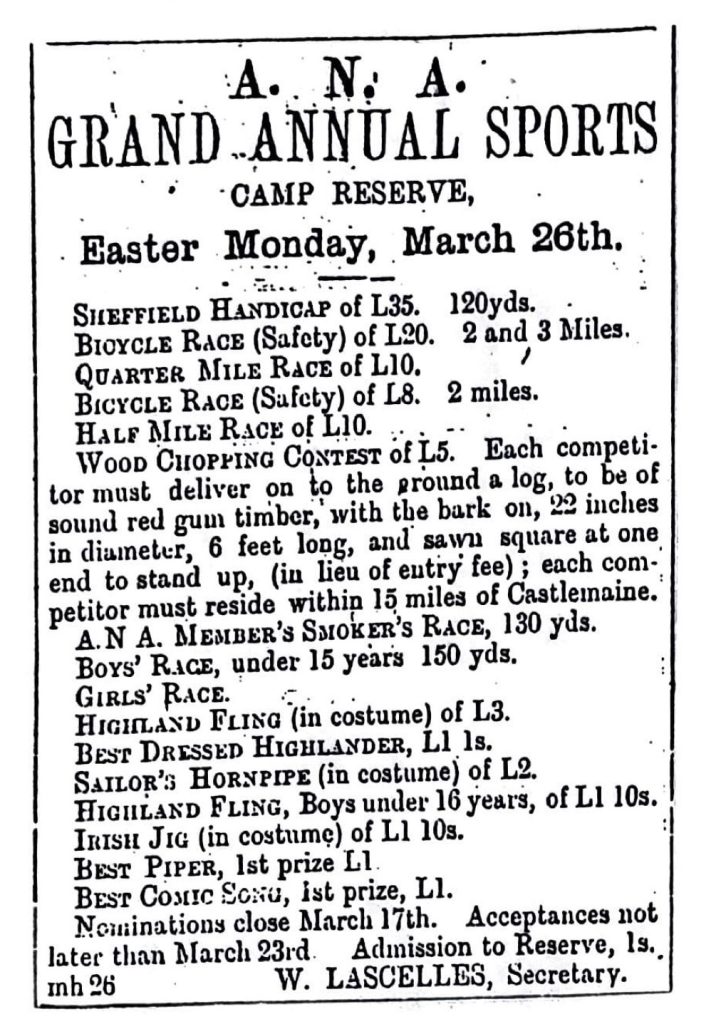
[TRANSCRIPT:]
A.N.A GRAND ANUAL SPORTS. Camp Reserve,
Easter Monday, March 26th.
SHEFFILED HANDICAP of L35. 120 yds.
BICYLES RACE (Safety) of L20. 2 and 3 miles.
QUARTER MILE RACE of L10.
BICYLES RACE (Safety) of L8. 2 miles
HALF MILE RACE OF L10.
WOODCHOPPING CONTEST of L5. Each competitor must deliver on to the ground a log, to be of sound rem gum timber, with the bark on, 22 inches in diameter, 6 feet long, and sawn square at one end to stand up, (in lieu of entry fee); each competitor must reside within 15 miles of Castlemaine.
A.N.A MEMBER’S SMOKER’S RACE, 130 yds.
BOY’S RACE, under 15 years 150 yds.
GIRL’S RACE
HIGHLAND FLING (in costume) of L3
BEST DRESSED HIGHLANDER, L1 1s
SAILOR’S HORNPIPE (in costume) of L2.
HIGHLAND FLING, Boys under 16 years, of L1 10s.
IRISH JIG (in costume) of L1 10s.
BEST PIPER, 1st prize, L1
Nominations close March 17th. Acceptance notes later than March 23rds. Admissions to Reserve, 1s [unintelligible]
W. LASCELLES, Secretary.
There were races for younger attendees, dancing events- like the ‘Highland Fling’, wood chopping contests; and music. Even ‘best piper’ was a competition.
The woodchopping contest added the condition that:
“… each competitor must reside within 15 miles [~24km*] of Castlemaine.” (7)
The Gift finals were the races that boasted the bigger prize money. But before anyone could compete in the finals, contenders of the Gift and other foot races were required to win three smaller races with other similar competitors – called ‘heats’.
Heats were used to qualify athletes for the Semi-Finals, and are still used today. The winners were timed and this was often also used to handicap the more successful runners; in an effort to make the Finals fair for all competitors.
The Sheffield handicap sparked mild controversy, when the Final was contested. Intercolonial cricketer, J.H Stuckey was declared the winner, with Bailey and Gordon second and third, respectively. (8)
The value of the Gift prizes had increased in the 30 years too, in proportion with the success of the event.
In 1894, the prize was £25 ($7200 in 2023**), which at that time was around half a year’s total wages. (9)

